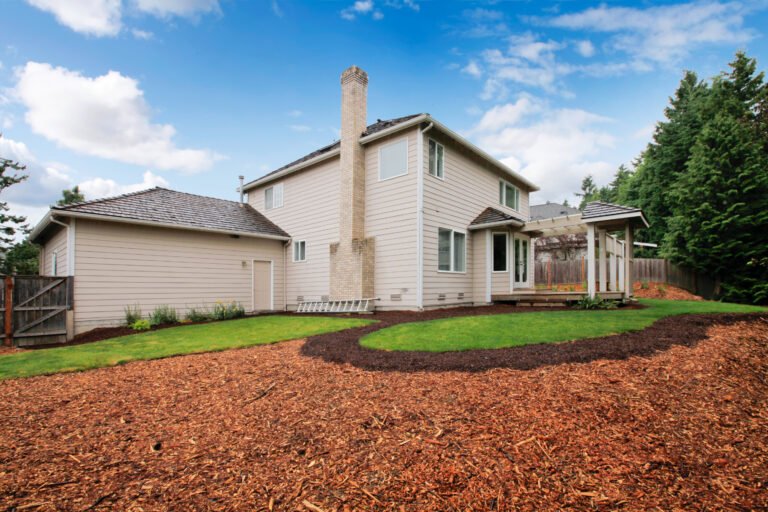Are you bothered with a lot of weeds in your garden? If you said yes, then this article is for you!
We all know that a landscape fabric waives the vines and keeps the weeds away. However, its installation & high cost might worry you. And, since the material isn’t natural and decomposable, it might even kill your plants!
So, what’s the solution? The answer is better landscape fabric alternatives that keep the weeds at bay and make your yard fertile. So, here is a list of 10 materials that will work as fine fabric alternatives and revive your garden on a budget. So, let’s dig into the list.
A List of Landscape Fabric Alternatives for Better Weed Control
Landscape fabric alternatives come in various sizes, materials, lifespans, and uses, each with a different packing process and function. So, we analyzed different options and handpicked a few for better weed control and drainage.
1. Wood Chips or Bark Mulch
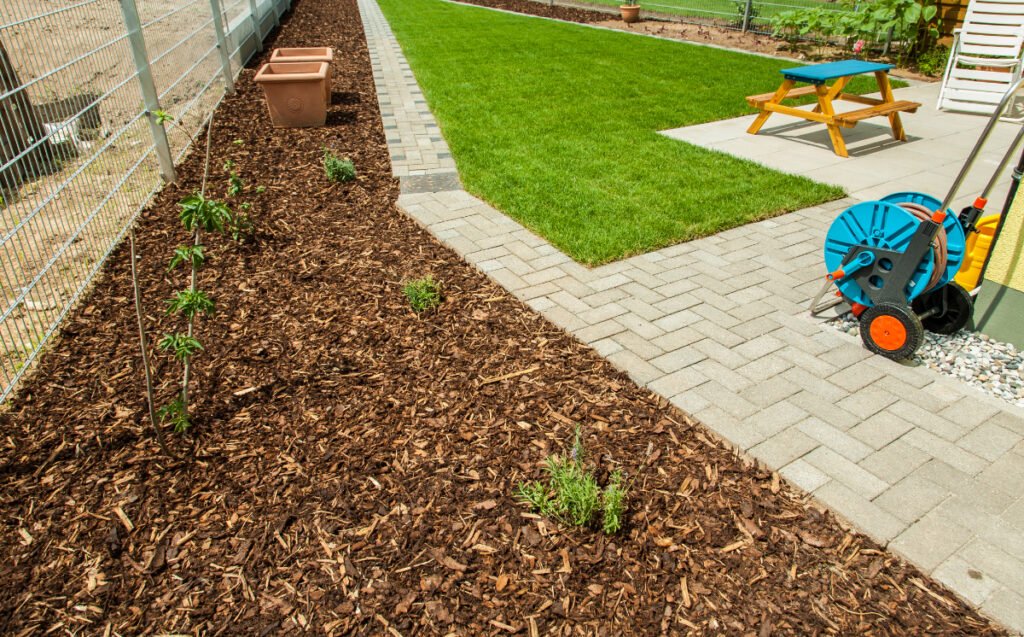
What Is It: Bark Mulch is nothing but a hard compost made from wood chips and clippings, fallen twigs, leaves, and sawdust from any local furniture or wood shaving company.
Bark mulch not only protects from weeds and pests like any other landscape barrier but also breaks down and provides nutrition to taller trees and plants. For example, you can use Cedar mulch for pest resistance, Pine mulch for nitrogen, or Hemlock mulch for vitamin C.
Bark mulch also retains more groundwater than a landscape fabric, resists surface evaporation, and keeps the soil temperature in check. So, you can use it to retain more moisture along your shrubs and save thirsty plants in drier or tropical climates.
However, many people mistake bark mulch for temporary use, but it can last for about 7 – 10 years if maintained properly. So, water it regularly and add different plant fertilizers to slow down the degradation. Or, you can use thicker Cedar or Oak mulches for long-term use.
And, avoid using wood chips from any painted furniture or laminated door shavings, as these may pollute the soil and load the plant with chemicals.
Where to Use: Use a 2-3 inch layer around ornamental plants, fruit trees, or potted plants.
| Average Cost | $ 2 – 3 per cubic foot |
| Average Lifespan | 7 – 10 years |
| Preferred Climate | Tropical to dry, and desert-like |
Pros:
- Retains soil temperature and moisture
- Natural and environment-friendly
- Supplies helpful plant minerals and nutrition
- Protects from weeds and flooding
- Reduces soil erosion
- Protects the plants from diseases and pests
Cons:
- Disrupts the natural pH of the soil
- Can catch fire on misuse
- Might attract termites and ants
- Can compact and discolor over time
Don’t stack bark mulch under trees and shrubs as these may attract termites and harm your plants. Instead, keep a gap of ½ feet between them and spray neem oil to repel the pests.
2. Pine Needles
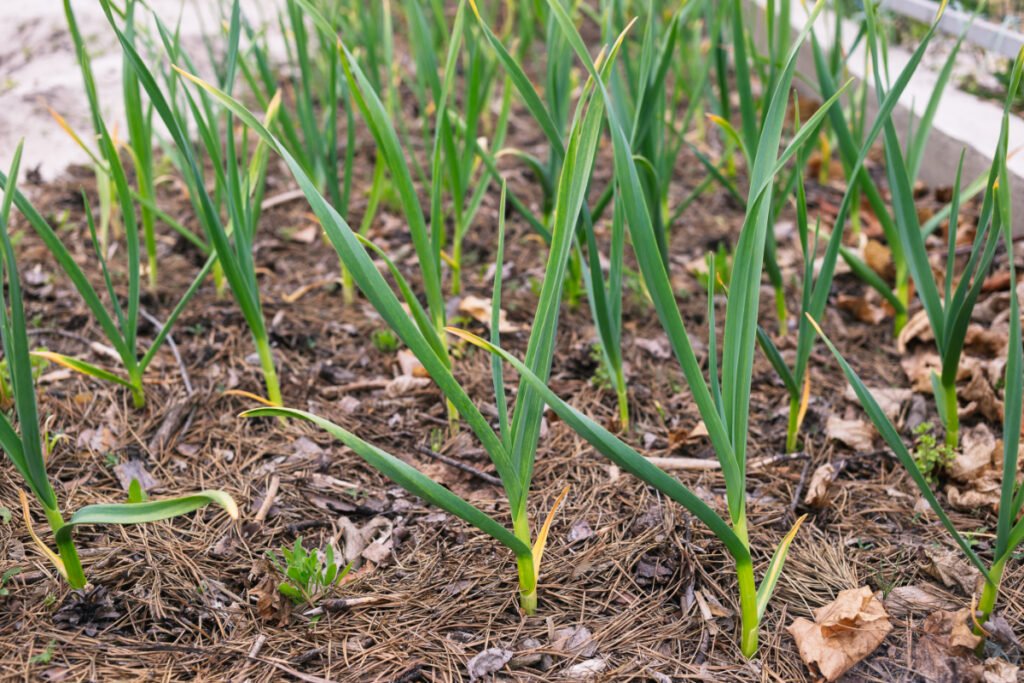
What Are They: Pine needles are the thin, needle-like leaves of pine or conifer trees that emit a solid insect-repelling scent for better plant health.
A 4-5 inch thick pine needle cover is a great way to suppress weed growth and soil erosion like any landscape fabric. It also adds more nitrogen and keeps the organic matter in check. It doesn’t interfere with the soil pH and reinforces proper root growth.
Moreover, pine needles are excellent water retainers and can direct the water flow in shallower trench drains and curtain drains. They even hold smaller drainage gravel like landscape fabric and reduce flooding in high-rainfall zones.
However, pine needles are highly flammable. So, you mustn’t use them in drier or tropical climates prone to fire hazards. Or you can use a fire-resistant Canary Island Pine needle or mix it with decomposed granite for better fire control.
Furthermore, pine needles are quite rough and might feel bumpy on driveways and pathways. So, it’s best to top them with soil or sand and replace them after 1-2 years for better performance.
Where to Use: Use it directly under your shrubs and plants, or line it along a drainage trench.
| Average Cost | Free to $1 – 2 per cubic foot |
| Average Lifespan | 1 – 2 years |
| Preferred Climate | Tropical, Coastal, or High-humidity zones |
Pros:
- Cheap and easy to pour
- Controls soil erosion and weed growth
- Adds more carbon and nitrogen to the soil
- Supports heavy gravel and grass
Cons:
- Extremely flammable and porous
- Rough and hard
- Lower lifespan and durability
- Can blow away in storms and gales
Use a thicker 4-5 inch needle layer in humid regions, but prefer a 2-inch layer in drier areas to retain water.
3. Straw
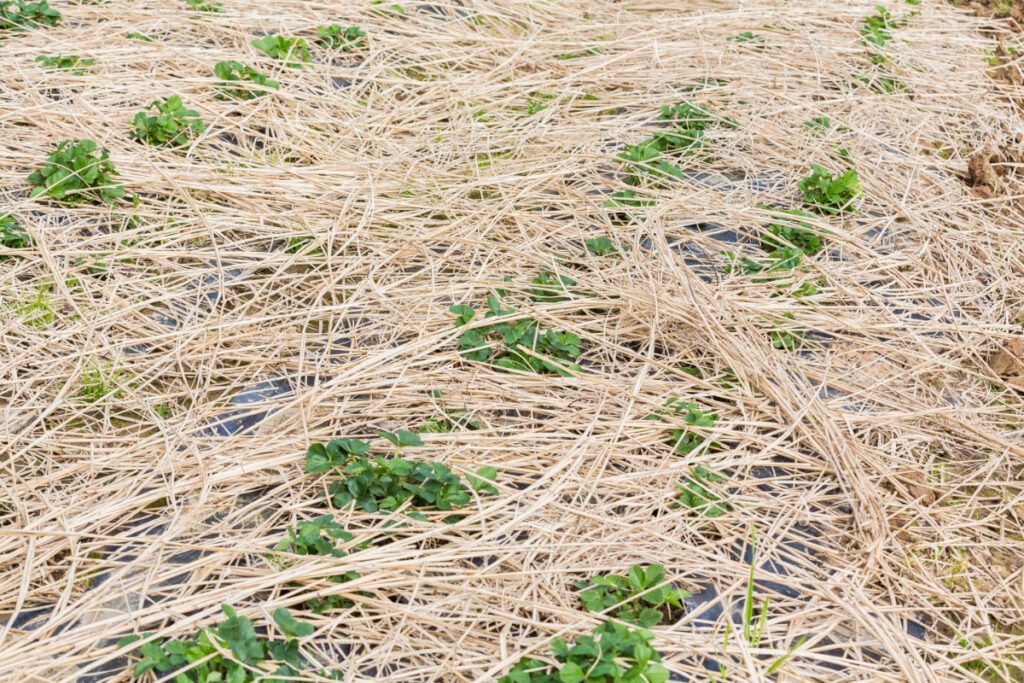
Straw is nothing but simple dry wheat or barley stalk that functions as an excellent weed barrier and prevents moisture from escaping the soil. Needless to say, it retains more water than a typical landscape fabric and might cause flooding around stormwater drains.
Similarly, it prevents the sun from reaching the soil and keeps it humid. This does stop the weed growth but might attract mildew and fungi that can harm the plants. So, sprinkle some neem oil over the straw or mix it with leaf mulch for better air circulation.
But, straw is more affordable than a landscape fabric and adds more nutrition to the soil. So, you can use it in your flower beds and gardens with less rain and sloping terrain.
Where to Use: Around vegetable gardens and flower beds.
| Average Cost | $ 30 – 40 per bale |
| Average Lifespan | 200 – 500 years |
| Preferred Climate | Hot and Dry |
Pros:
- Natural and nutritional to the soil
- Prevents soil erosion
- Lightweight and easy to lay
- Adds more moisture
Cons:
- Might be expensive for larger gardens
- Must be mulched for more compaction
- Might contain additional weed seed
Use a high-pressure water hose to wet your straw and compact it once a week.
4. Biodegradable Plastic
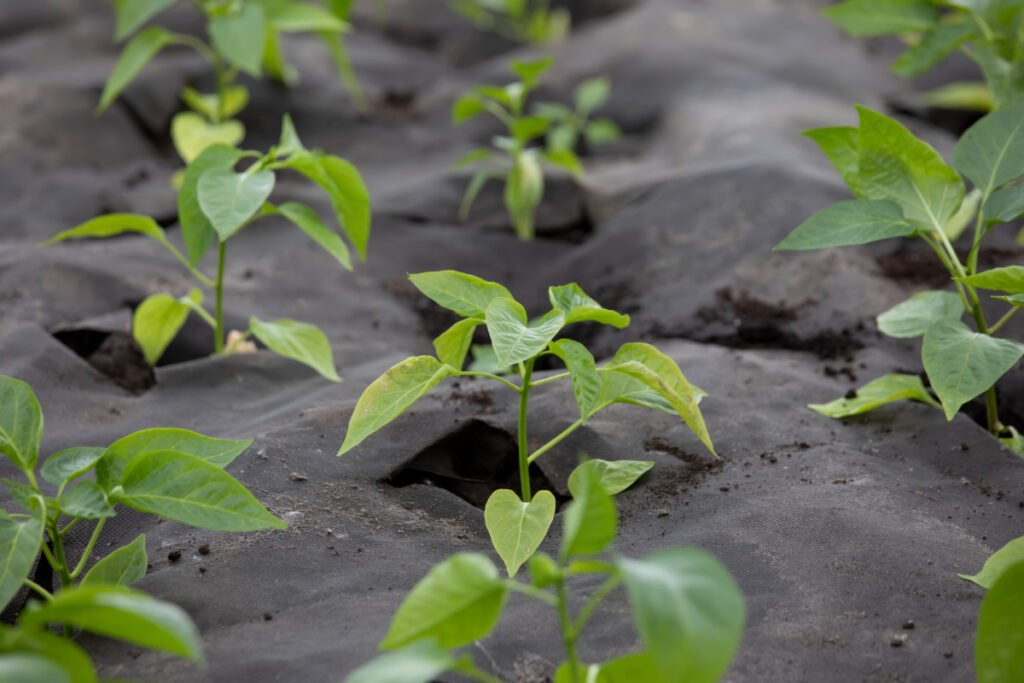
What Is It: Biodegradable plastic is an alkane, plastic-like material that easily decomposes with excess biomass and microbes in the soil.
Biodegradable plastic is very similar to a landscape fabric and can be used for adequate drainage and water flow in low-lying yards. It prevents surface water percolation and supports perforated drain pipes efficiently.
Similarly, it prevents weed growth and protects the plant from pests and worms. It also maintains the correct soil temperature and doesn’t disrupt its pH.
However, biodegradable plastic lasts only 8-9 months and might tear after that. So, it needs frequent replacements and might not suit deeper trench drains. But, you can use it with a combination of butter paper or cardboard for more durability.
Where to Use: Around garden rows and shallower drains.
| Average Cost | $ 2 – 6 per kg |
| Average Lifespan | 8 – 9 months |
| Preferred Climate | High-rainfall, Temperate, and Dry climates |
Pros:
- Affordable
- Excellent drainage and water flow
- Maintains soil temperature
Cons:
- Difficult to lay and install
- Needs additional drip tape and screws for better strength
- Requires frequent replacement
Biodegradable plastic might absorb moisture and make your soil dry. So, drill some small holes at every 1M for better water seepage.
5. Burlap
What Is It: Burlap is a thin canvas, jute, or hemp sack with wider weaves and a porous membrane for better landscape control.
Burlap is like any other landscape fabric; You’ll need to line it and add adequate pins and screws to hold it in the ground. And it even goes with typical french drains or weed barriers like any non-woven geotextile.
But, burlap is more porous than a conventional landscape fabric and allows a proper exchange of air and water to facilitate plant growth. Thus, it maintains the correct soil temperature, moisture, and fertility effortlessly.
Plus, it is entirely bio-degradable and acts like a powerhouse of carbon, potassium, and nitrogen in the soil. So, you better not use excessive herbicides with burlap and maintain your soil naturally.
However, many people often find weed sprouts in burlap due to its high moisture content. But, they won’t seep inside the soil and instead prevent evaporation of surface water extensively.
Where to Use: Around garden plants, bushes, trees, and deeper french drains.
| Average Cost | $50 – 80 for a 12-yard roll |
| Average Lifespan | 1 – 1.5 years |
| Preferred Climate | Dry and Temperate |
Pros:
- Easy to line like any landscape fabric
- High water retention
- Completely organic and biodegradable
- Controls soil temperature and fertility
Cons:
- Might grow weeds in the gaps
- Slightly expensive
- Doesn’t work with inorganic mulch or pea gravel
- Needs frequent replacement
Always use a natural burlap fabric in the garden as synthetic ones might contaminate the soil and damage your plants.
6. Cardboard
What Is It: A cardboard is a heavy-duty paperboard or boxboard with a corrugated sheeting for better porosity.
Cardboard is a strong yet flexible plant-pulp barrier that can be used to prevent weeds and pests as it can fit in all the smaller gaps around your plants. You can even wet or crush it to clippings for better ground coverage and mixing.
Typically, cardboard has a high water-retention capacity and will preserve the natural moisture and pH of your soil. So, you’ll need to remove all the cello tapes, plastic films, or staples for more water absorption and less pollution.
But cardboard can still attract termites and pests and might ruin flowering plants. So, don’t forget to spray some pesticide and top the cardboard with drain rock, just like a landscape fabric. Or, use a thicker board and sprinkle some zinc powder for more efficiency.
Where to Use: Around drier areas with thorny scrub and cacti.
| Average Cost | $50 – 90 per bale |
| Average Lifespan | 2 – 3 years |
| Preferred Climate | Drier or Desert regions |
Pros:
- Completely biodegradable and natural
- Affordable
- High water flow and retention
- Recyclable
Cons:
- Doesn’t go with rubber or gravel mulch
- Attracts ants and termites
- Might blow with the wind and create a mess
Use cardboard as the bottom layer and top it off with mulch and gravel for better weed and moisture control.
7. Newspaper
Newspapers are free, but they are excellent weed barriers, just like any landscape fabric. They are also simpler to lay and can be thrown and packed in any area. But, you’ll need a firm 4-5 sheet thick layer to eliminate weeds.
Newspapers aren’t as toxic as landscape fabrics and contain nutritious soy ink that supplies protein and potassium to your plants. Plus, they allow sunlight and moisture to reach the plant roots and aid development.
But, newspapers have poor drainage and might cause root rot in high-rainfall areas. And, it isn’t as stable as landscape fabric and might blow away with the wind. So, limit it to smaller areas or mix it with soil for support.
Where to Use: Around flowering trees, vegetable gardens, and decks.
| Average Cost | Free |
| Average Lifespan | 7 – 8 months |
| Preferred Climate | Temperate to Tropical |
Pros:
- Biodegradable
- Easily available and free to use
- Renewable and recyclable
- Flexible and easy to pack
Cons:
- Doesn’t mix with smaller pea gravel or mulch
- Need frequent replacement
- Lesser drainage and water control
Never mix glossy or magazine papers in the soil as they might contaminate soil and reduce its fertility.
8. Groundcover Plants
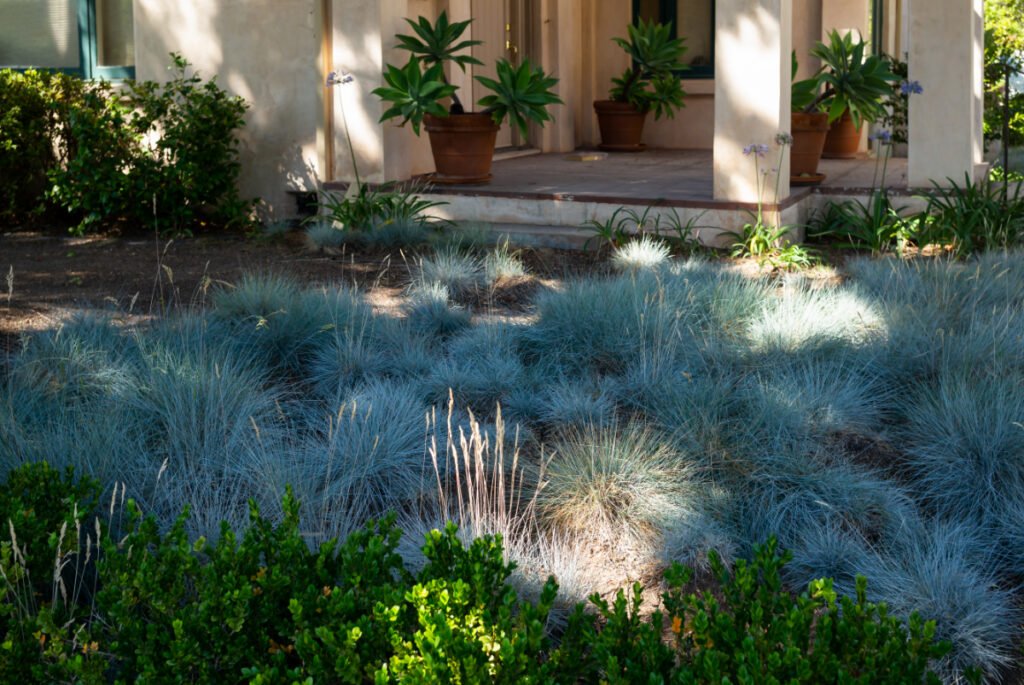
Groundcover plants are a great drainage option against traditional landscape fabrics to effectively channel the surface water and reduce flooding in low-lying areas. And they even cover the drain pipe and keep the soil and sediment away.
Groundcover plants are also great water filters and remove most pollutants from surface water. So, you can use them around catchbasins, shallow curtain or trench drains, and dry wells to reduce clogging.
Additionally, these prevent soil erosion like any landscape fabric but maintain the soil temperature, humidity, and water flow. Thus, planting them around larger trees, dry creeks, and flowerbeds is advisable.
However, many people find maintaining these plants in drier climates challenging. Yes, groundcovers are indeed moisture-loving, but you need to pair them with river rock and bunds to sustain their water level in dry areas.
Where to Use: Confined spaces, Bunds, Sloping areas, and Drainage systems.
Plants to Use: Juniper, Ajuga, Mondo grass, Creeping fig, Ivy, Lady fern, Vinca vine.
| Average Cost | $ 7 – 10 per pound |
| Average Lifespan | 10 – 20 years |
| Preferred Climate | Tropical and Humid, Can be planted in dry areas with good irrigation |
Pros:
- Natural and Decomposable
- Greater lifespan and durability
- Prevent soil erosion and root rot
Cons:
- Need frequent trimming
- Heavy maintenance and watering
- Might attract worms and insects
Use coarse netting to establish the ground cover on slopes and ramps. Or, add a 2-3 inch mulch layer to support the plants.
9. Butter Paper or Baking Paper
Butter paper is a great landscape fabric alternative to prevent excess weed growth in gardens and shrub beds. And it not only allows the rain and sun to reach the soil and maintains the correct pH and humidity.
However, it’s inefficient for drainage and might sog and break with heavy rain. Still, you can use it to protect PVC pipes from excess sedimentation. Or, you can shred it and mix it with the soil too.
In contrast, butter paper is an excellent plant fertilizer and helps growth, unlike a conventional landscape fabric. It also serves as a great earthworm food and restores soil fertility with time.
Where to Use: Directly under the plants and shrub beds.
| Average Cost | $ 1 – 2 per roll |
| Average Lifespan | 2 – 3 years |
| Preferred Climate | Humid, but moderate rainfall |
Pros:
- Inexpensive and biodegradable
- Prevents erosion and promotes soil health
- Retains moisture and soil temperature
Cons:
- Poor drainage
- Might break with heavy rainfall
- Can blow with the wind
Replace butter paper with simple garden paper or packaging paper rolls if you live in a windy area.
10. Gravel or Rocks
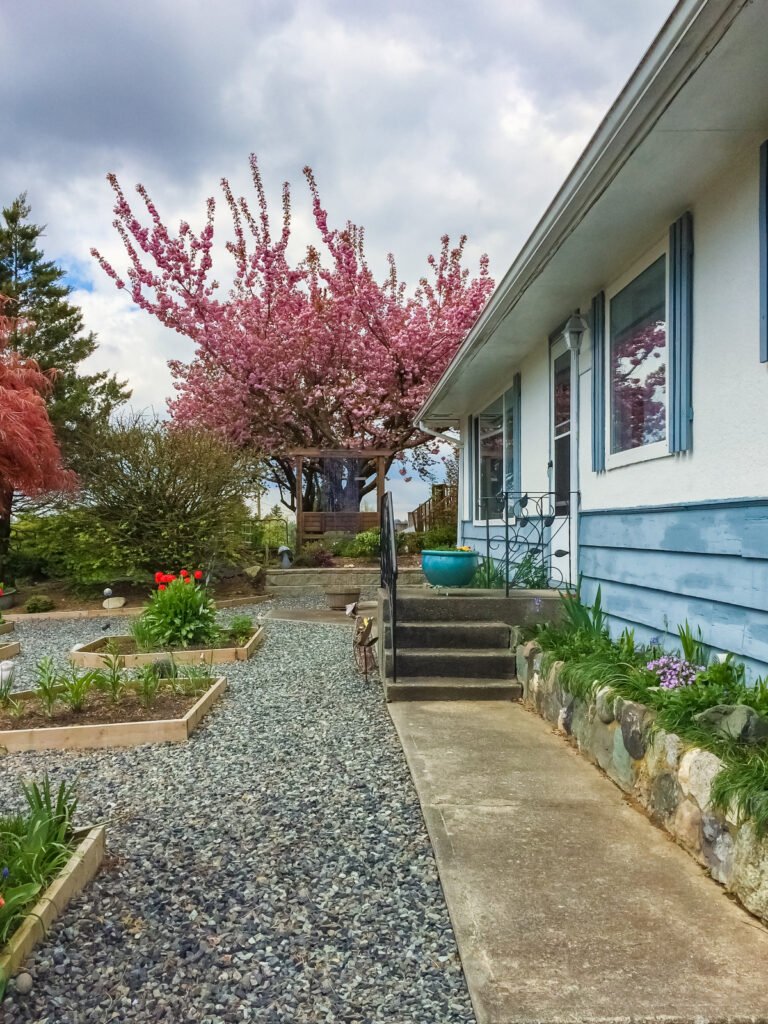
Gravel is yet another landscape fabric alternative for good drainage and works to reduce marshiness in low-lying areas with uniform water distribution and channeling. So, it might prevent root rot and mildew in the garden.
Additionally, it doesn’t break down like landscape fabric and lasts a lifetime. It also filters the soil and sediment and prevents your drain pipes from clogging.
However, smaller gravel might sink into the soil and reduce its efficiency in the long run. So, adding another weed barrier or plastic sheet becomes necessary. Or, you could simply use a larger 1-2 inch river rock, pack it in place, and have a maintenance-free alternative quickly.
Where to Use: Around trench drains, french drains, dry wells or flowerbeds and rock gardens.
| Average Cost | $ 1 – 3 per square foot |
| Average Lifespan | Lifetime |
| Preferred Climate | Works with every climate |
Pros:
- Affordable and Easy to pack
- Good drainage and water flow
- Reduces soil temperature and dryness
- Reduces fungi and mildew
Cons:
- Won’t add any nutrition to your garden or flower bed
- Might mix with soil and lose its compaction
- Might get dirty easily
- Heavy to lift
Use 1-2 inch river rock for drainage purposes, but pick smaller pea gravel or decomposed granite dirt for planting.
Why Should You Consider Landscape Fabric Alternatives for Your Yard?
Standard landscape fabrics are heavy, difficult to lay and pack different pollutants and contaminants that destroy your soil’s fertility. And, they might let in the worms and pests and destroy all the harvest in your yard.
In contrast, landscape fabric alternatives are more affordable, easy to pack, and have numerous benefits, as listed below.
- Soil-friendly: Fabric alternatives are fully decomposable and nourish the earthworms and ants, enhancing soil fertility. But, a landscape garden is much stiffer and might kill plants with prolonged use.
- Greater Porosity: These alternatives are pretty porous and allow rainwater to percolate into the soil, unlike a typical landscape fabric that blocks the soil from air and water exposure.
- Boosts Plant Health: Fabric alternatives are softer on the plant roots, allowing them to branch and grow between their gaps. In contrast, a landscape fabric hinders root growth and might dry the plant.
- Affordability: These alternatives are affordable and easy to DIY with simple tools and equipment, whereas a typical landscape fabric is costly to purchase and install.
Tips for Installing Landscape Fabric Alternatives in Your Yard
- Always clear the existing weeds before you pack the gravel or mulch.
- Don’t try to install the alternatives on windy days, as they may blow and tear before you pack them.
- Always add good-quality compost before you add the weed barrier to enhance plant health.
- Pack sand or pea gravel under the cardboards and newspapers for better drainage.
How to Reduce Weed Growth in Tropical Climates?
- Mix corn gluten in newspapers and carboards to stop new weed seeds from germinating.
- Mix one part vinegar in three parts water and half part dish soap and spray it over your mulch to kill all the weeds instantly.
- Dip the wood chips or bark mulch in rubbing alcohol to enhance its durability and reduce the moisture that helps weed growth.
- Spray abrasive herbicides or pesticides directly over the weeds and spray neem oil over the soil to stop weed growth.
Can You Use a Plastic Sheet Instead of a Landscape Fabric?
No, you shouldn’t use plastic as it reduces the water flow and might break down into different pollutants that contaminate the soil. However, you can use a biodegradable plastic sheet for plants and drains, but you’ll need it to replace it frequently.
How Do You Get Rid of the Weeds in Gravel Gaps?
You can sprinkle some table salt or vinegar between the gravel gaps and naturally kill all the weeds. Otherwise, it’s best to uproot them with forceps.
Can Worms Get in Through Different Fabric Alternatives?
Yes, worms can get in through different fabric alternatives, but it’s a good thing and will maintain the necessary nutrients in the soil. Plus, worms will also help decompose the mulch and newspaper and boost soil fertility.
When Should You Still Prefer a Landscape Fabric?
Landscape fabric alternatives are decomposable and lightweight but can’t handle the weight of paved areas and drain rocks. So, it’s best to use landscape fabric under your pathways, patios, driveways, and deeper french drains.
Landscape fabrics are popular and efficient but have some shortcomings with the material and installation. So, you can consider different fabric alternatives that are completely decomposable, nutritious, lightweight, and equally capable of reducing weed growth.
Moreover, these also offer good drainage and water flow and prevent excess water seepage in shallower trench and french drains. But what if you have a deeper french drain or basement drain? Well, don’t worry; we have already listed the best landscape fabrics here.

